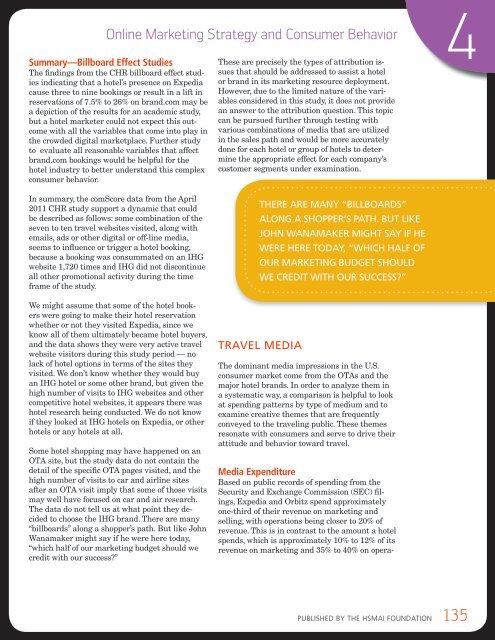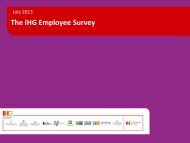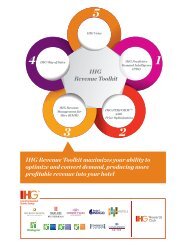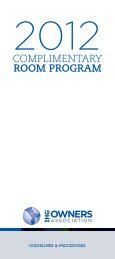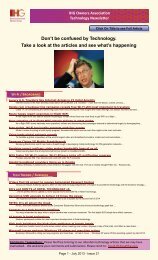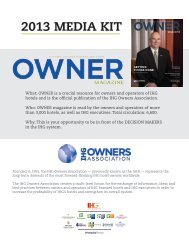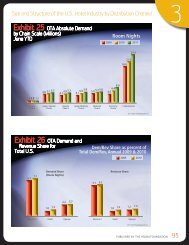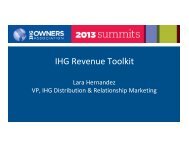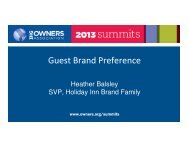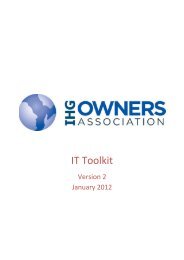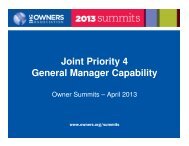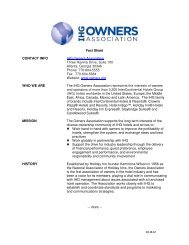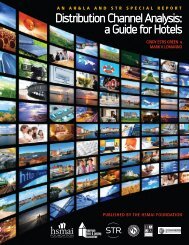Online Marketing Strategy and Consumer Behavior - IHG Owners ...
Online Marketing Strategy and Consumer Behavior - IHG Owners ...
Online Marketing Strategy and Consumer Behavior - IHG Owners ...
Create successful ePaper yourself
Turn your PDF publications into a flip-book with our unique Google optimized e-Paper software.
<strong>Online</strong> <strong>Marketing</strong> <strong>Strategy</strong> <strong>and</strong> <strong>Consumer</strong> <strong>Behavior</strong><br />
Summary—Billboard Effect Studies<br />
The findings from the CHR billboard effect studies<br />
indicating that a hotel’s presence on Expedia<br />
cause three to nine bookings or result in a lift in<br />
reservations of 7.5% to 26% on br<strong>and</strong>.com may be<br />
a depiction of the results for an academic study,<br />
but a hotel marketer could not expect this outcome<br />
with all the variables that come into play in<br />
the crowded digital marketplace. Further study<br />
to evaluate all reasonable variables that affect<br />
br<strong>and</strong>.com bookings would be helpful for the<br />
hotel industry to better underst<strong>and</strong> this complex<br />
consumer behavior.<br />
In summary, the comScore data from the April<br />
2011 CHR study support a dynamic that could<br />
be described as follows: some combination of the<br />
seven to ten travel websites visited, along with<br />
emails, ads or other digital or off-line media,<br />
seems to influence or trigger a hotel booking,<br />
because a booking was consummated on an <strong>IHG</strong><br />
website 1,720 times <strong>and</strong> <strong>IHG</strong> did not discontinue<br />
all other promotional activity during the time<br />
frame of the study.<br />
We might assume that some of the hotel bookers<br />
were going to make their hotel reservation<br />
whether or not they visited Expedia, since we<br />
know all of them ultimately became hotel buyers,<br />
<strong>and</strong> the data shows they were very active travel<br />
website visitors during this study period — no<br />
lack of hotel options in terms of the sites they<br />
visited. We don’t know whether they would buy<br />
an <strong>IHG</strong> hotel or some other br<strong>and</strong>, but given the<br />
high number of visits to <strong>IHG</strong> websites <strong>and</strong> other<br />
competitive hotel websites, it appears there was<br />
hotel research being conducted. We do not know<br />
if they looked at <strong>IHG</strong> hotels on Expedia, or other<br />
hotels or any hotels at all.<br />
Some hotel shopping may have happened on an<br />
OTA site, but the study data do not contain the<br />
detail of the specific OTA pages visited, <strong>and</strong> the<br />
high number of visits to car <strong>and</strong> airline sites<br />
after an OTA visit imply that some of those visits<br />
may well have focused on car <strong>and</strong> air research.<br />
The data do not tell us at what point they decided<br />
to choose the <strong>IHG</strong> br<strong>and</strong>. There are many<br />
“billboards” along a shopper’s path. But like John<br />
Wanamaker might say if he were here today,<br />
“which half of our marketing budget should we<br />
credit with our success?”<br />
These are precisely the types of attribution issues<br />
that should be addressed to assist a hotel<br />
or br<strong>and</strong> in its marketing resource deployment.<br />
However, due to the limited nature of the variables<br />
considered in this study, it does not provide<br />
an answer to the attribution question. This topic<br />
can be pursued further through testing with<br />
various combinations of media that are utilized<br />
in the sales path <strong>and</strong> would be more accurately<br />
done for each hotel or group of hotels to determine<br />
the appropriate effect for each company’s<br />
customer segments under examination.<br />
thErE arE many “bIllboards”<br />
along a shoppEr’s path. but lIkE<br />
john wanamakEr mIght say If hE<br />
wErE hErE today, “whIch half of<br />
our markEtIng budgEt should<br />
wE crEdIt wIth our succEss?”<br />
travEl mEdIa<br />
The dominant media impressions in the U.S.<br />
consumer market come from the OTAs <strong>and</strong> the<br />
major hotel br<strong>and</strong>s. In order to analyze them in<br />
a systematic way, a comparison is helpful to look<br />
at spending patterns by type of medium <strong>and</strong> to<br />
examine creative themes that are frequently<br />
conveyed to the traveling public. These themes<br />
resonate with consumers <strong>and</strong> serve to drive their<br />
attitude <strong>and</strong> behavior toward travel.<br />
Media Expenditure<br />
Based on public records of spending from the<br />
Security <strong>and</strong> Exchange Commission (SEC) filings,<br />
Expedia <strong>and</strong> Orbitz spend approximately<br />
one-third of their revenue on marketing <strong>and</strong><br />
selling, with operations being closer to 20% of<br />
revenue. This is in contrast to the amount a hotel<br />
spends, which is approximately 10% to 12% of its<br />
revenue on marketing <strong>and</strong> 35% to 40% on opera-<br />
4<br />
Published by the hsMAi FoundAtion 135


